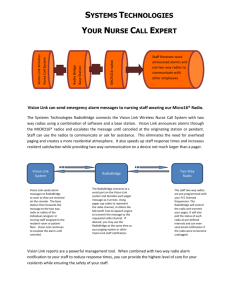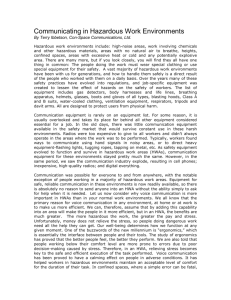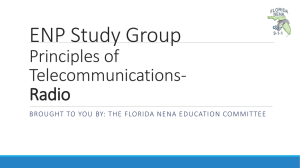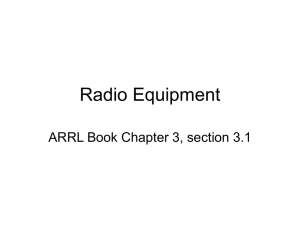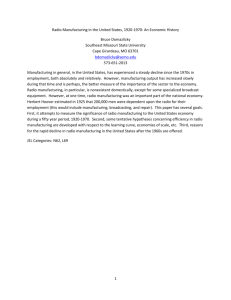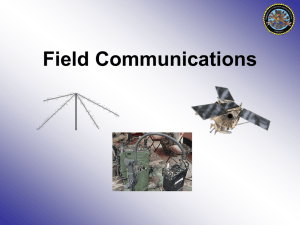- Defense GameTech Users
advertisement
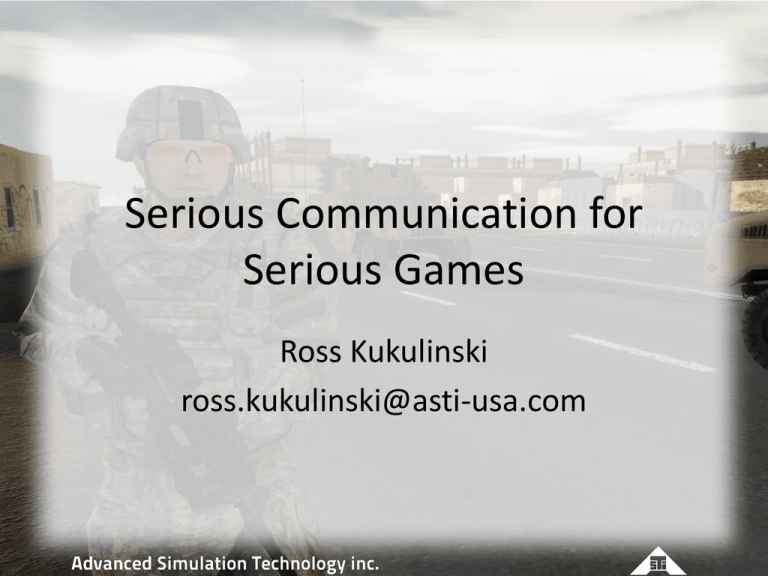
Serious Communication for Serious Games Ross Kukulinski ross.kukulinski@asti-usa.com Photo by Derek Jensen 2 Photo Courtesy of U.S. Military 3 Tutorial Roadmap 1. 2. 3. 4. 5. Serious games overview Team communication & teamwork Current game communication systems Qualities of effective communication systems Final thoughts and future directions 4 Part 1 Serious Games are Powerful Tools 5 Serious Games … • Allow soldiers to experience situations that are impossible in the real world1 • Provide improved hand-eye coordination, multi-tasking, and teamwork2 • Are uniquely flexible to support varied training needs 1 Corti, 2006; Squire & Jenkins, 2003 2 Michael & Chen, 2006 6 Serious Game Design Broad Topic – Why Games Work – The Science of Learning, I/ITSEC 2011 Best Tutorial, Curtiss Murphy – A Theory of Fun for Game Design, Ralph Koster – Serious Game Design and Development, CannonBowers and Bowers 7 ‘Good’ Serious Games Six Ingredients to a ‘good’ game1 1. 2. 3. 4. 5. 6. 7. Mechanics Rules Immersive Graphics Interactivity Challenge Risks What about communication? 1 Derryberry, 2007 8 Part 2 Team Communication and Teamwork “…coordination and cooperation among team members are foundational to the mission’s success” – Serious Games that Improve Performance, McGowan & Pecheux 9 Fundamentals of Teamwork The Big Five Core Components of Teamwork1 1. 2. 3. 4. 5. Team Leadership Performance Monitoring Backup Behavior Adaptability Team/Collective Orientation Hypothesis: Communication key element? 1 Salas, Sims, & Burke, 2004 10 Communication and Performance • America’s Army experiments – Researchers measured team communication • Communication network level • Number of report-ins • Number of normal communications • Teams with regular organized reports had: – Higher performance – Higher estimated situational awareness Schneider & Carley, 2005 11 DARWARS Ambush!: Authoring Lessons Learned in a Training Game1 • Communication skills are critical for success – Requires effective communications training • Communications capabilities differ widely across varying military units • Training system should be similar to real-world communication system 1 Diller, Orberts, Blankenship, Nielsen, 2004 12 DARWARS Lessons Cont’d • Primary functions of a convoy commander – Establish and maintain communications within the convoy – Maintain communication with superordinate and subordinate element commanders Diller, Orberts, Blankenship, Nielsen, 2004 13 Part 3 Current Game Communication System Capabilities 14 Game Communication Options • • • • Nothing Text-chat Game integrated voice communication Third-party voice communication None simulate real-world communication! 15 Our Customer Feedback • Some were content with what they had • Some engineered custom solutions • Many were frustrated – Current game communication systems… • • • • • are not robust are difficult to manage in large installations do not simulate real-world radio communication do not integrate well with other training systems lack live technical support and expertise 16 Communication Specifications • Game After Ambush – 8,118 words in technical specification – 128 words for describing communication • Games for Training (Draft – October 2011) – 5,113 words in technical specification – 128 words for describing communication 17 Part 4 Qualities of Effective Communication Systems 18 Communication System Requirements 1. 2. 3. 4. 5. 6. Simulate real-world communication Centralized configuration In-game user interface Game integration L-V-C interoperation Exercise management tools 19 1. Simulate Real-world Communication • Simulated radios behave like real-world radios – AM, FM, SINCGARS, HAVEQUICK, intercom – Half-duplex radios – Full-duplex intercoms – Real-time dynamic radio noise – Realistic propagation effects due to ranging, occulting and radio power level – Crypto system sound effects 20 1. Simulate Real-world Communication • Simulate voice communication – Volume and quality degrades over distance – Separate from radio simulation • Trainees limited to channels they would have in real-world (i.e. MBITR squad only) 21 2. Centralized Configuration • Most game classrooms have 30+ trainees • Configuration should be centralized – Radio configuration • Frequencies, modes, crypto, etc. – Communication profiles • How many radios • How are they configured? – Network configuration (DIS, IPs, etc.) 22 3. In-game User Interface • • • • Support for multiple radios and intercoms View radio channel and Tx/Rx status Support changing radio channel Ability to switch communication profile 23 4. Game Integration • Radio location from game entities for realistic radio effects like ranging • Player location for voice-communication • Assign radios to vehicles for mounted training – Players acquire vehicle-based radios when mounted, lose access when dismounted • After Action Review – Seek, FF, RW, Bookmarks 24 5. L-V-C Interoperation • CCTT & AVCATT & other flight simulators – Flight trainers configuration is inflexible – Requires full-fidelity radio simulation and strict adherence to DIS standards • BCTC/MTC classrooms • Interoperate with live radios • Support mobile devices (i.e. Android) 25 L-V-C Example 26 6. Exercise Management Tools • Radio analysis tool – Live display of all radios on simulation network – Search, sort, and compare radios • Player monitor – View all connected players, current status • Configuration lock-down – Prevent players from changing configuration 27 Robust! “Any game-based training system…must be robust enough to allow for flexibility, it must also guard against user or environmental factors that could mitigate training value.” Hussain & Ferguson, 2005 28 Part 5 Final Thoughts 29 Raise the bar • Communication must be core element of training and training budgets • Improve communication requirements spec – Communications modeling – L-V-C interoperation – Exercise management 1Hussain, et al. 30 Resources • • • • • • • • • • • Carpenter, R., White, C., (2005) Commercial Computer Games in the Australian Department of Defense Corti, K. (2006) Games-based Learning; a serious business application. Derryberry, A. (2007) Serious Games: online games for learning Diller, D., Roberts, B., Blankenship, S., Nielsen, D. (2004) DARWARS Ambush! Authoring Lessons Learned in a Training Game Hussain, T., etal (2010) Development of game-based training systems: Lessons learned in an inter-disciplinary field in the making Hussain T. & Ferguson, W. (2005) Efficient Development of Large-Scale Military Training Environments using a Multi-Player Game McGowan, C., Pecheux, B. (2007) Serious Games that Improve Performance Michael, D., & Chen, S. (2006) Serious games: Games that educate, train and inform Sims E., Salas E., Burke S. (2004) Is There a ‘Big Five’ in Teamwork Snider, M., Carley K., Moon, I. (2005) Detailed Comparison of America’s Army and Unit of Action Experiments Squire, K. & Jenkins, H. (2003) Harnessing the power of games in education 31 Thank You! Ross Kukulinski Advanced Simulation Technology inc. ross.kukulinski@asti-usa.com (650) 262-6559 32 Communication Specification 9.0 Communications The GAA product shall simulate at least three and up to five tactical communications networks using Voice Over Internet Protocol (VOIP) or other packet switched networks. The system shall conserve bandwidth so that voice traffic correlates with the events occurring within the game environment. Each user shall have multichannel VOIP capability to communicate with each game client and the client‘s users via microphone/speakers or headset. The system shall also reduce any sound lag and ensure that any lag is imperceptible to the user (human ear). The system shall be able to capture VOIP traffic for playback. The VOIP recording shall be capable of synchronizing to the time and the events of the AAR file during playback and segregate to each of the client user‘s voice channels. 33 Future Directions • Closer integration between radios and game environment • Radio effects based on virtual-world terrain • SAF voice and radio traffic • Scalability for cloud based applications • Communication analysis to assess teamwork and soldier evaluation during AAR 34
